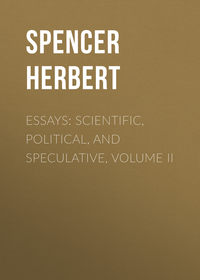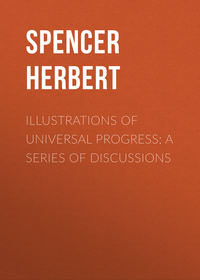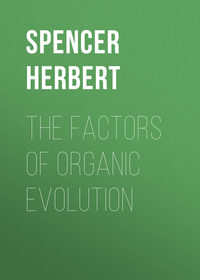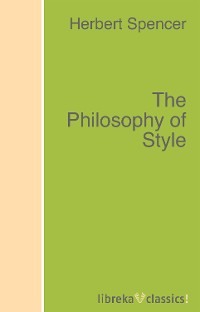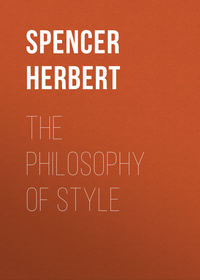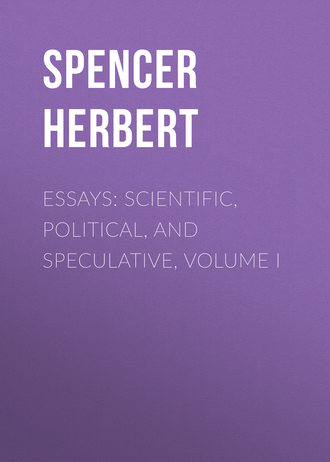 полная версия
полная версияEssays: Scientific, Political, and Speculative, Volume I
There is an antagonist hypothesis which does not propose to honour the Unknown Power manifested in the Universe, by such titles as "The Master-Builder," or "The Great Artificer;" but which regards this Unknown Power as probably working after a method quite different from that of human mechanics. And the genealogy of this hypothesis is as high as that of the other is low. It is begotten by that ever-enlarging and ever-strengthening belief in the presence of Law, which accumulated experiences have gradually produced in the human mind. From generation to generation Science has been proving uniformities of relation among phenomena which were before thought either fortuitous or supernatural in their origin – has been showing an established order and a constant causation where ignorance had assumed irregularity and arbitrariness. Each further discovery of Law has increased the presumption that Law is everywhere conformed to. And hence, among other beliefs, has arisen the belief that the Solar System originated, not by manufacture but by evolution. Besides its abstract parentage in those grand general conceptions which Science has generated, this hypothesis has a concrete parentage of the highest character. Based as it is on the law of universal gravitation, it may claim for its remote progenitor the great thinker who established that law. It was first suggested by one who ranks high among philosophers. The man who collected evidence indicating that stars result from the aggregation of diffused matter, was the most diligent, careful, and original astronomical observer of modern times. And the world has not seen a more learned mathematician than the man who, setting out with this conception of diffused matter concentrating towards its centre of gravity, pointed out the way in which there would arise, in the course of its concentration, a balanced group of sun, planets, and satellites, like that of which the Earth is a member.
Thus, even were there but little direct evidence assignable for the Nebular Hypothesis, the probability of its truth would be strong. Its own high derivation and the low derivation of the antagonist hypothesis, would together form a weighty reason for accepting it – at any rate, provisionally. But the direct evidence assignable for the Nebular Hypothesis is by no means little. It is far greater in quantity, and more varied in kind, than is commonly supposed. Much has been said here and there on this or that class of evidences; but nowhere, so far as we know, have all the evidences been fully stated. We propose here to do something towards supplying the deficiency: believing that, joined with the a priori reasons given above, the array of a posteriori reasons will leave little doubt in the mind of any candid inquirer.
And first, let us address ourselves to those recent discoveries in stellar astronomy which have been supposed to conflict with this celebrated speculation.
When Sir William Herschel, directing his great reflector to various nebulous spots, found them resolvable into clusters of stars, he inferred, and for a time maintained, that all nebulous spots are clusters of stars exceedingly remote from us. But after years of conscientious investigation, he concluded that "there were nebulosities which are not of a starry nature;" and on this conclusion was based his hypothesis of a diffused luminous fluid which, by its eventual aggregation, produced stars. A telescopic power much exceeding that used by Herschel, has enabled Lord Rosse to resolve some of the nebulæ previously unresolved; and, returning to the conclusion which Herschel first formed on similar grounds but afterwards rejected, many astronomers have assumed that, under sufficiently high powers, every nebula would be decomposed into stars – that the irresolvability is due solely to distance. The hypothesis now commonly entertained is, that all nebulæ are galaxies more or less like in nature to that immediately surrounding us; but that they are so inconceivably remote as to look, through ordinary telescopes, like small faint spots. And not a few have drawn the corollary, that by the discoveries of Lord Rosse the Nebular Hypothesis has been disproved.
Now, even supposing that these inferences respecting the distances and natures of the nebulæ are valid, they leave the Nebular Hypothesis substantially as it was. Admitting that each of these faint spots is a sidereal system, so far removed that its countless stars give less light than one small star of our own sidereal system; the admission is in no way inconsistent with the belief that stars, and their attendant planets, have been formed by the aggregation of nebulous matter. Though, doubtless, if the existence of nebulous matter now in course of concentration be disproved, one of the evidences of the Nebular Hypothesis is destroyed, yet the remaining evidences remain. It is a tenable position that though nebular condensation is now nowhere to be seen in progress, yet it was once going on universally. And, indeed, it might be argued that the still-continued existence of diffused nebulous matter is scarcely to be expected; seeing that the causes which have resulted in the aggregation of one mass, must have been acting on all masses, and that hence the existence of masses not aggregated would be a fact calling for explanation. Thus, granting the immediate conclusions suggested by these recent disclosures of the six-feet reflector, the corollary which many have drawn is inadmissible.
But these conclusions may be successfully contested. Receiving them though we have been, for years past, as established truths, a critical examination of the facts has convinced us that they are quite unwarrantable. They involve so many manifest incongruities, that we have been astonished to find men of science entertaining them, even as probable. Let us consider these incongruities.
In the first place, mark what is inferable from the distribution of nebulæ.
"The spaces which precede or which follow simple nebulæ," says Arago, "and a fortiori, groups of nebulæ, contain generally few stars. Herschel found this rule to be invariable. Thus every time that during a short interval no star approached in virtue of the diurnal motion, to place itself in the field of his motionless telescope, he was accustomed to say to the secretary who assisted him, – 'Prepare to write; nebulæ are about to arrive.'"
How does this fact consist with the hypothesis that nebulæ are remote galaxies? If there were but one nebula, it would be a curious coincidence were this one nebula so placed in the distant regions of space, as to agree in direction with a starless spot in our own sidereal system. If there were but two nebulæ, and both were so placed, the coincidence would be excessively strange. What, then, shall we say on finding that there are thousands of nebulæ so placed? Shall we believe that in thousands of cases these far-removed galaxies happen to agree in their visible positions with the thin places in our own galaxy? Such a belief is impossible.
Still more manifest does the impossibility of it become when we consider the general distribution of nebulæ. Besides again showing itself in the fact that "the poorest regions in stars are near the richest in nebulæ," the law above specified applies to the heavens as a whole. In that zone of celestial space where stars are excessively abundant, nebulæ are rare; while in the two opposite celestial spaces that are furthest removed from this zone, nebulæ are abundant. Scarcely any nebulæ lie near the galactic circle (or plane of the Milky Way); and the great mass of them lie round the galactic poles. Can this also be mere coincidence? When to the fact that the general mass of nebulæ are antithetical in position to the general mass of stars, we add the fact that local regions of nebulæ are regions where stars are scarce, and the further fact that single nebulæ are habitually found in comparatively starless spots; does not the proof of a physical connexion become overwhelming? Should it not require an infinity of evidence to show that nebulæ are not parts of our sidereal system? Let us see whether any such infinity of evidence is assignable. Let us see whether there is even a single alleged proof which will bear examination.
"As seen through colossal telescopes," says Humboldt, "the contemplation of these nebulous masses leads us into regions from whence a ray of light, according to an assumption not wholly improbable, requires millions of years to reach our earth – to distances for whose measurement the dimensions (the distance of Sirius, or the calculated distances of the binary stars in Cygnus and the Centaur) of our nearest stratum of fixed stars scarcely suffice."
In this confused sentence there is implied a belief, that the distances of the nebulæ from our galaxy of stars as much transcend the distances of our stars from one another, as these interstellar distances transcend the dimensions of our planetary system. Just as the diameter of the Earth's orbit, is a mere point when compared with the distance of our Sun from Sirius; so is the distance of our Sun from Sirius, a mere point when compared with the distance of our galaxy from those far-removed galaxies constituting nebulæ. Observe the consequences of this assumption.
If one of these supposed galaxies is so remote that its distance dwarfs our interstellar spaces into points, and therefore makes the dimensions of our whole sidereal system relatively insignificant; does it not inevitably follow that the telescopic power required to resolve this remote galaxy into stars, must be incomparably greater than the telescopic power required to resolve the whole of our own galaxy into stars? Is it not certain that an instrument which can just exhibit with clearness the most distant stars of our own cluster, must be utterly unable to separate one of these remote clusters into stars? What, then, are we to think when we find that the same instrument which decomposes hosts of nebulæ into stars, fails to resolve completely our own Milky Way? Take a homely comparison. Suppose a man who was surrounded by a swarm of bees, extending, as they sometimes do, so high in the air as to render some of the individual bees almost invisible, were to declare that a certain spot on the horizon was a swarm of bees; and that he knew it because he could see the bees as separate specks. Incredible as the assertion would be, it would not exceed in incredibility this which we are criticising. Reduce the dimensions to figures, and the absurdity becomes still more palpable. In round numbers, the distance of Sirius from the Earth is half a million times the distance of the Earth from the Sun; and, according to the hypothesis, the distance of a nebula is something like half a million times the distance of Sirius. Now, our own "starry island, or nebula," as Humboldt calls it, "forms a lens-shaped, flattened, and everywhere detached stratum, whose major axis is estimated at seven or eight hundred, and its minor axis at a hundred and fifty times the distance of Sirius from the Earth."11 And since it is concluded that the Solar System is near the centre of this aggregation, it follows that our distance from the remotest parts of it is some four hundred distances of Sirius. But the stars forming these remotest parts are not individually visible, even through telescopes of the highest power. How, then, can such telescopes make individually visible the stars of a nebula which is half a million times the distance of Sirius? The implication is, that a star rendered invisible by distance becomes visible if taken twelve hundred times further off! Shall we accept this implication? or shall we not rather conclude that the nebulæ are not remote galaxies? Shall we not infer that, be their nature what it may, they must be at least as near to us as the extremities of our own sidereal system?
Throughout the above argument, it is tacitly assumed that differences of apparent magnitude among the stars, result mainly from differences of distance. On this assumption the current doctrines respecting the nebulæ are founded; and this assumption is, for the nonce, admitted in each of the foregoing criticisms. From the time, however, when it was first made by Sir W. Herschel, this assumption has been purely gratuitous; and it now proves to be inadmissible. But, awkwardly enough, its truth and its untruth are alike fatal to the conclusions of those who argue after the manner of Humboldt. Note the alternatives.
On the one hand, what follows from the untruth of the assumption? If apparent largeness of stars is not due to comparative nearness, and their successively smaller sizes to their greater and greater degrees of remoteness, what becomes of the inferences respecting the dimensions of our sidereal system and the distances of nebulæ? If, as has lately been shown, the almost invisible star 61 Cygni has a greater parallax than [Greek: a] Cygni, though, according to an estimate based on Sir W. Herschel's assumption, it should be about twelve times more distant – if, as it turns out, there exist telescopic stars which are nearer to us than Sirius; of what worth is the conclusion that the nebulæ are very remote, because their component luminous masses are made visible only by high telescopic powers? Clearly, if the most brilliant star in the heavens and a star that cannot be seen by the naked eye, prove to be equidistant, relative distances cannot be in the least inferred from relative visibilities. And if so, nebulæ may be comparatively near, though the starlets of which they are made up appear extremely minute.
On the other hand, what follows if the truth of the assumption be granted? The arguments used to justify this assumption in the case of the stars, equally justify it in the case of the nebulæ. It cannot be contended that, on the average, the apparent sizes of the stars indicate their distances, without its being admitted that, on the average, the apparent sizes of the nebulæ indicate their distances – that, generally speaking, the larger are the nearer and the smaller are the more distant. Mark, now, the necessary inference respecting their resolvability. The largest or nearest nebulæ will be most easily resolved into stars; the successively smaller will be successively more difficult of resolution; and the irresolvable ones will be the smallest ones. This, however, is exactly the reverse of the fact. The largest nebulæ are either wholly irresolvable, or but partially resolvable under the highest telescopic powers; while large numbers of quite small nebulæ are easily resolved by far less powerful telescopes. An instrument through which the great nebula in Andromeda, two and a half degrees long and one degree broad, appears merely as a diffused light, decomposes a nebula of fifteen minutes diameter into twenty thousand starry points. At the same time that the individual stars of a nebula eight minutes in diameter are so clearly seen as to allow of their number being estimated, a nebula covering an area five hundred times as great shows no stars at all! What possible explanation of this can be given on the current hypothesis?
Yet a further difficulty remains – one which is, perhaps, still more obviously fatal than the foregoing. This difficulty is presented by the phenomena of the Magellanic clouds. Describing the larger of these, Sir John Herschel says: —
"The Nubecula Major, like the Minor, consists partly of large tracts and ill-defined patches of irresolvable nebula, and of nebulosity in every stage of resolution, up to perfectly resolved stars like the Milky Way, as also of regular and irregular nebulæ properly so called, of globular clusters in every stage of resolvability, and of clustering groups sufficiently insulated and condensed to come under the designation of 'clusters of stars.'" —Cape Observations, p. 146.
In his Outlines of Astronomy, Sir John Herschel, after repeating this description in other words, goes on to remark that —
"This combination of characters, rightly considered, is in a high degree instructive, affording an insight into the probable comparative distance of stars and nebulæ, and the real brightness of individual stars as compared with one another. Taking the apparent semidiameter of the nubecula major at three degrees, and regarding its solid form as, roughly speaking, spherical, its nearest and most remote parts differ in their distance from us by a little more than a tenth part of our distance from its center. The brightness of objects situated in its nearer portions, therefore, cannot be much exaggerated, nor that of its remoter much enfeebled, by their difference of distance; yet within this globular space, we have collected upwards of six hundred stars of the seventh, eighth, ninth, and tenth magnitudes, nearly three hundred nebulæ, and globular and other clusters, of all degrees of resolvability, and smaller scattered stars innumerable of every inferior magnitude, from the tenth to such as by their multitude and minuteness constitute irresolvable nebulosity, extending over tracts of many square degrees. Were there but one such object, it might be maintained without utter improbability that its apparent sphericity is only an effect of foreshortening, and that in reality a much greater proportional difference of distance between its nearer and more remote parts exists. But such an adjustment, improbable enough in one case, must be rejected as too much so for fair argument in two. It must, therefore, be taken as a demonstrated fact, that stars of the seventh or eighth magnitude and irresolvable nebula may co-exist within limits of distance not differing in proportion more than as nine to ten." —Outlines of Astronomy (10th Ed.), pp. 656-57.
This supplies yet another reductio ad absurdum of the doctrine we are combating. It gives us the choice of two incredibilities. If we are to believe that one of these included nebulæ is so remote that its hundred thousand stars look like a milky spot, invisible to the naked eye; we must also believe that there are single stars so enormous that though removed to this same distance they remain visible. If we accept the other alternative, and say that many nebulæ are no further off than our own stars of the eighth magnitude; then it is requisite to say that at a distance not greater than that at which a single star is still faintly visible to the naked eye, there may exist a group of a hundred thousand stars which is invisible to the naked eye. Neither of these suppositions can be entertained. What, then, is the conclusion that remains? This only: – that the nebulæ are not further from us than parts of our own sidereal system, of which they must be considered members; and that when they are resolvable into discrete masses, these masses cannot be considered as stars in anything like the ordinary sense of that word.12
And now, having seen the untenability of this idea, rashly espoused by sundry astronomers, that the nebulæ are extremely remote galaxies; let us consider whether the various appearances they present are not reconcilable with the Nebular Hypothesis.
Given a rare and widely-diffused mass of nebulous matter, having a diameter, say, of one hundred times that of the Solar System,13 what are the successive changes that may be expected to take place in it? Mutual gravitation will approximate its atoms or its molecules; but their approximation will be opposed by that atomic motion the resultant of which we recognize as repulsion, and the overcoming of which implies the evolution of heat. As fast as this heat partially escapes by radiation, further approximation will take place, attended by further evolution of heat, and so on continuously: the processes not occurring separately as here described, but simultaneously, uninterruptedly, and with increasing activity. When the nebulous mass has reached a particular stage of condensation – when its internally-situated atoms have approached to within certain distances, have generated a certain amount of heat, and are subject to a certain mutual pressure, combinations may be anticipated. Whether the molecules produced be of kinds such as we know, which is possible, or whether they be of kinds simpler than any we know, which is more probable, matters not to the argument. It suffices that molecular unions, either between atoms of the same kind or between atoms of different kinds, will finally take place. When they do take place, they will be accompanied by a sudden and great disengagement of heat; and until this excess of heat has escaped, the newly-formed molecules will remain uniformly diffused, or, as it were, dissolved in the pre-existing nebulous medium.
But now what may be expected by and by to happen? When radiation has adequately lowered the temperature, these molecules will precipitate; and, having precipitated, they will not remain uniformly diffused, but will aggregate into flocculi; just as water, precipitated from air, collects into clouds. Concluding, thus, that a nebulous mass will, in course of time, resolve itself into flocculi of precipitated denser matter, floating in the rarer medium from which they were precipitated, let us inquire what are the mechanical results to be inferred. Of clustered bodies in empty space, each will move along a line which is the resultant of the tractive forces exercised by all the rest, modified from moment to moment by the acquired motion; and the aggregation of such clustered bodies, if it eventually results at all, can result only from collision, dissipation, and the formation of a resisting medium. But with clustered bodies already immersed in a resisting medium, and especially if such bodies are of small densities, such as those we are considering, the process of concentration will begin forthwith: two factors conspiring to produce it. The flocculi described, irregular in their shapes and presenting, as they must in nearly all cases, unsymmetrical faces to their lines of motion, will be deflected from those courses which mutual gravitation, if uninterfered with, would produce among them; and this will militate against that balancing of movements which permanence of the cluster pre-supposes. If it be said, as it may truly be said, that this is too trifling a cause of derangement to produce much effect, then there comes the more important cause with which it co-operates. The medium from which the flocculi have been precipitated, and through which they are moving, must, by gravitation, be rendered denser in its central parts than in its peripheral parts. Hence the flocculi, none of them moving in straight lines to the common centre of gravity, but having courses made to diverge to one or other side of it (in small degrees by the cause just assigned, and in much greater degrees by the tractive forces of other flocculi) will, in moving towards the central region, meet with greater resistances on their inner sides than on their outer sides; and will be thus made to diverge outwardly from their courses more than they would otherwise do. Hence a tendency which, apart from other tendencies, will cause them severally to go on one or other side of the centre of gravity, and, approaching it, to get motions more and more tangential. Observe, however, that their respective motions will be deflected, not towards one side of the common centre of gravity, but towards various sides. How then can there result a movement common to them all? Very simply. Each flocculus, in describing its course, must give motion to the medium through which it is moving. But the probabilities are infinity to one against all the respective motions thus impressed on this medium, exactly balancing one another. And if they do not balance one another the result must be rotation of the whole mass of the medium in one direction. But preponderating momentum in one direction, having caused rotation of the medium in that direction, the rotating medium must in its turn gradually arrest such flocculi as are moving in opposition, and impress its own motion upon them; and thus there will ultimately be formed a rotating medium with suspended flocculi partaking of its motion, while they move in converging spirals towards the common centre of gravity.14
Before comparing these conclusions with facts, let us pursue the reasoning a little further, and observe certain subordinate actions. The respective flocculi must be drawn not towards their common centre of gravity only, but also towards neighbouring flocculi. Hence the whole assemblage of flocculi will break up into groups: each group concentrating towards its local centre of gravity, and in so doing acquiring a vortical movement like that subsequently acquired by the whole nebula. According to circumstances, and chiefly according to the size of the original nebulous mass, this process of local aggregation will produce various results. If the whole nebula is but small, the local groups of flocculi may be drawn into the common centre of gravity before their constituent masses have coalesced with one another. In a larger nebula, these local aggregations may have concentrated into rotating spheroids of vapour, while yet they have made but little approach towards the general focus of the system. In a still larger nebula, where the local aggregations are both greater and more remote from the common centre of gravity, they may have condensed into masses of molten matter before the general distribution of them has greatly altered. In short, as the conditions in each case determine, the discrete masses produced may vary indefinitely in number, in size, in density, in motion, in distribution.




